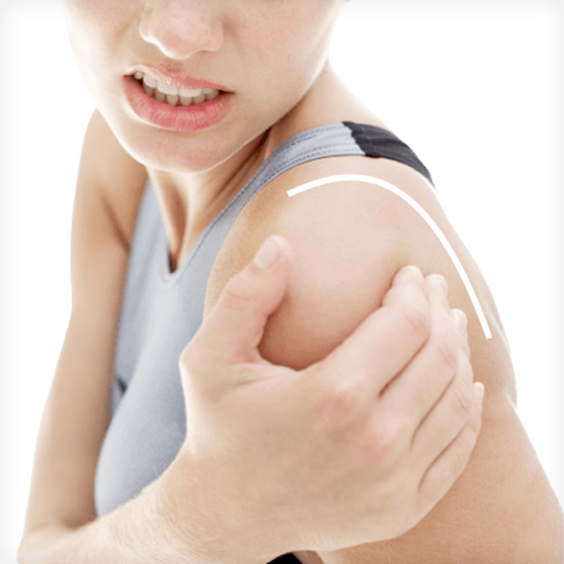SHOULDER PAIN
About Shoulder Pain
Shoulder pain is a common condition in Singapore and affects people across all lifestyles, from office workers who spend long hours at the computer to individuals who participate in recreational sports like badminton, swimming or tennis. The shoulder is a complex joint supported by bones, ligaments, muscles and tendons that allow wide movement. Because of this complexity, it can be vulnerable to strain, irritation or injury.
At Singapore Paincare, our pain specialists use minimally invasive procedures to address your condition and provide an alternative to long term reliance on painkillers or open surgery. Our targeted treatments aim to relieve pain with little or no downtime and reduce the risk of long term stiffness or frozen shoulder.

What Are The Causes Of Shoulder Pain?
Shoulder pain arises when any of the structures that support the shoulder joint become irritated, strained or injured. The shoulder is formed by three main bones: the humerus (upper arm), the scapula (shoulder blade) and the collarbone. These bones are stabilised by the rotator cuff, a group of four muscles and their tendons that guide smooth movement. When these tissues are stressed or damaged, pain and restricted movement can develop. Common causes include:
- Rotator cuff strain or irritation: Repetitive lifting, overhead work or sudden force can irritate or injure the rotator cuff. This leads to inflammation, weakness and pain when raising or rotating the arm.
- Soft tissue inflammation: Tendinitis and bursitis are frequent causes of shoulder pain in Singapore, especially among individuals with active sports routines or people who sit for long hours with rounded posture. Inflamed tendons or bursae reduce shoulder movement and cause discomfort during daily tasks.
- Muscle or tendon tears: Tears may occur with sudden injuries or long term wear. Even partial tears can cause night pain, weakness and difficulty with overhead activities.
- Bone related problems: Fractures of the humerus, scapula or collarbone may occur after falls or accidents. These injuries cause immediate pain, swelling and limitation.
- Joint related conditions: Shoulder arthritis, rheumatoid arthritis or joint degeneration reduce the smooth movement of the joint. Stiffness often worsens in the morning or after periods of inactivity.
- Joint instability or dislocation: Previous dislocations or loose ligaments can cause repeated slipping sensations, weakness or pain during movement.
In many cases, shoulder pain is driven by soft tissue problems rather than bone abnormalities. Even when scans appear normal, the pain may come from irritated tendons, overworked muscles or early inflammation that affects movement.
What Are The Types Of Shoulder Pain?
TENDINITIS & MUSCLE-RELATED SHOULDER PAIN
These conditions often occur from repetitive shoulder use or sudden overexertion.
- Shoulder Tendinitis: Irritation of a tendon due to lifting, overhead work or strenuous activity. Pain worsens with movement and may limit daily tasks.
- Bursitis: Inflammation of the bursa that cushions movement between tissues. Pain increases when the arm is raised or rotated.
- Shoulder Impingement Syndrome: The rotator cuff tendons are pinched between surrounding bone structures. Symptoms include sharp pain when lifting the arm or lowering it.
- Shoulder Spasm or Strain: Overstretching of the muscles or ligaments around the joint. The area may feel tender or tight and movement can become limited.
DEGENERATIVE OR STRUCTURAL SHOULDER PAIN
Pain is related to damage or degeneration within the joint.
- Shoulder Arthritis: Gradual wear of the cartilage causes stiffness, swelling and pain that worsens with activity.
- Shoulder Rotator Cuff Tear: Partial or full thickness tears may occur due to sudden injury or long term wear. Symptoms include night pain, weakness, and difficulty lifting the arm.
- Shoulder Joint Degeneration: Age or repetitive stress may narrow joint spaces and irritate nearby tissues.
INJURY-RELATED SHOULDER PAIN
Sudden trauma or movement can injure ligaments, tendons or muscles.
- Shoulder Sprain: Stretching or tearing of ligaments after falls or abrupt force. Severe cases may cause instability or bruising.
- Direct Impact Injuries: Sports collisions or falls on an outstretched arm can lead to deeper soft tissue injuries.
NERVE RELATED SHOULDER PAIN
Some shoulder pain conditions are driven by nerve involvement.
- Shoulder Girdle Syndrome (Parsonage Turner Syndrome): A rare condition caused by inflammation of the brachial plexus. It begins with sudden severe pain followed by muscle weakness.
CAPSULAR DISORDER
This condition occurs when the shoulder joint capsule becomes thickened, tight, and inflamed. The capsule normally allows smooth movement of the shoulder, but when it stiffens, it restricts motion and causes pain.
- Frozen shoulder (Adhesive Capsulitis): This disorder develops gradually and progresses through stages. Individuals may experience deep aching pain and difficulty with movements such as reaching overhead or behind the back. Without early treatment, the stiffness can last many months and significantly affect daily activities.
What Are the Symptoms of Shoulder Pain?
Shoulder pain symptoms can range from mild discomfort to severe movement restriction. If symptoms persist, cause sleep disturbance or reduce function, it is advisable to see shoulder pain specialist in Singapore.
- Pain with movement: Pain may occur when reaching overhead, dressing, carrying items or lying on the affected side.
- Swelling or tenderness: The affected area may appear swollen, warm or bruised after injury.
- Instability: The shoulder may feel loose or at risk of slipping out of place.
- Restricted daily functions: Pain can interfere with sleep, work tasks or recreational activities.
What Are The Treatment Options For Shoulder Pain In Singapore?
CONSERVATIVE TREATMENTS
Most mild to moderate shoulder pain responds well to non surgical care.
- Physical Treatment: Stretching and strengthening exercises help improve mobility and support the rotator cuff. Therapists use manual techniques and guided movements to reduce pain.
- Rest, Ice and Support: Short periods of rest, cold application and temporary shoulder supports can reduce inflammation.
- Medication: Pain relievers or anti inflammatory medications may provide early symptom relief.
MINIMALLY INVASIVE PROCEDURES
For persistent pain or structural injury, targeted procedures can treat the pain source while avoiding open surgery. At Singapore Paincare, we offer a range of minimally invasive treatments that relieve pain precisely at its origin.
- Coreflex Injection: A targeted injection that reduces inflammation within tendons or bursae to allow smoother movement.
- Platelet Rich Plasma (PRP): PRP uses the patient’s own platelets to stimulate healing of injured tendons or soft tissues.
SURGICAL TREATMENT
Surgery is rarely required. It may be considered if there is severe structural damage or failure of other treatments.
- Arthroscopy: A minimally invasive scope procedure to inspect and repair internal shoulder structures.
- Shoulder Joint Replacement: Reserved for severe arthritis or joint damage when all other options have been exhausted.
How Does Singapore Paincare Treat Shoulder Pain?
At Singapore Paincare, our pain specialists draw upon the proprietary Painostic know-how—an in-house approach to pain management developed from years of clinical experience. Through comprehensive, multi-dimensional assessment, our pain specialists work to identify the underlying causes of your shoulder pain and develop an individualised treatment plan tailored to your shoulder pain condition, delivered using specialized interventional techniques.
We strive to use the least invasive option possible to address your pain effectively. We specialise in targeted injection therapies and minimally invasive procedures, complemented by pharmacological treatments and cognitive and physical rehabilitative therapies. This integrated approach aims to help patients achieve pain relief, improve function, and reduce the risk of recurrence.
Our pain specialists’ commitment to combining thorough diagnostic evaluation with technical precision ensures that every patient receives individualised care aimed at effective pain management.
How To Prevent Shoulder Pain?
- Maintain good posture during work and computer use.
- Warm up before sports that involve overhead movement such as badminton or swimming.
- Take regular breaks from repetitive tasks.
- Strengthen shoulder stabiliser muscles to reduce strain during daily activities.
- Avoid lifting heavy items with poor technique.
A Message About Shoulder Pain From Singapore Paincare’s Pain Specialist
Shoulder pain often begins as a mild ache but can gradually limit daily activities such as reaching, lifting or sleeping comfortably. Many people assume shoulder pain comes from bone spurs, yet muscle strain, tendon irritation or bursitis are often the real causes. Without treatment, the joint can become stiff and may progress toward frozen shoulder.
At Singapore Paincare, our Painostic approach helps us understand the true origin of your shoulder pain. We create a personalised plan using minimally invasive techniques that support faster recovery and restore comfortable movement.
Frequently Asked Questions
A muscle strain is usually localised and improves with rest. Rotator cuff injuries often cause weakness, difficulty lifting the arm and pain at night.
Seek specialist care if shoulder pain lasts more than a few weeks, affects arm strength, limits movement or interrupts sleep.
Most procedures allow return to light activities within one to two days. Your doctor will advise based on the treatment performed.
Selected minimally invasive procedures may be claimable under Medisave, Integrated Shield Plans or corporate insurance. Our staff can help check your eligibility.
They offer faster recovery, precise treatment of pain sources, smaller incisions and lower risk compared to open surgery.
If pain persists after six to twelve weeks of conservative care, or if symptoms worsen, consider assessment by a pain specialist. Seek urgent help for sudden weakness, severe pain or trauma.






